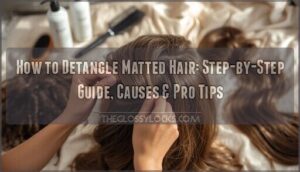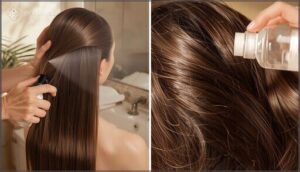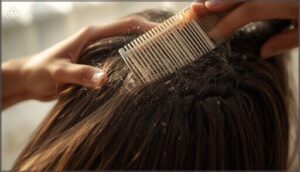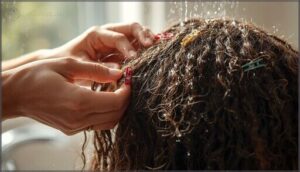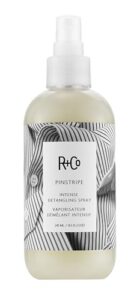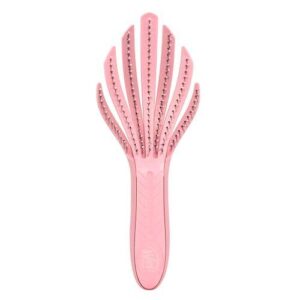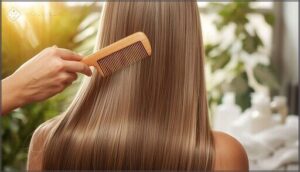This site is supported by our readers. We may earn a commission, at no cost to you, if you purchase through links.
A single loose strand turns into a knot, and before you know it, your hair’s taken on a life of its own—clumped, tight, and impossible to ignore. Matted hair doesn’t discriminate; it sneaks up on the careful and the carefree, especially after rough nights or tangled days.
Every tug feels like a battle, but with the right know-how and tools, you can reclaim control. Whether your hair hangs in twisting curls or straight sheets, learning how to detangle matted hair means less pain, less breakage, and a smoother, healthier start for your next style.
Table Of Contents
- Key Takeaways
- What is Matted Hair?
- Common Causes of Matted Hair
- Step-by-Step Guide to Detangling Matted Hair
- Top 3 Products for Detangling Matted Hair
- What to Do if Detangling Doesn’t Work
- Tips to Prevent Matted Hair in The Future
- Frequently Asked Questions (FAQs)
- How do you untangle severely matted hair?
- How do you comb detangled hair?
- Should you detangle hair when wet or dry?
- Do you need a detangling shampoo to detangle matted hair?
- Can you detangle dry hair?
- Does apple cider vinegar detangle matted hair?
- How can you prevent matted hair?
- Can matted hair cause scalp irritation or pain?
- How long does detangling matted hair usually take?
- Are there home remedies to soften severe matting?
- Conclusion
Key Takeaways
- Matted hair forms dense, hard clumps that are different from regular tangles and often require a careful, step-by-step approach to detangle safely.
- Curly, coily, fine, and long hair types are most at risk for matting, especially when regular detangling, moisture, and protective practices are neglected.
- The best way to tackle matted hair is to use the right products, section your hair, start detangling from the ends with gentle tools, and work slowly to prevent breakage.
- If gentle detangling doesn’t work and mats persist, it’s safest to seek professional help or, in severe cases, consider trimming to prevent lasting damage.
What is Matted Hair?
If your hair has ever felt more like a knot than a manageable style, you’re not alone. Matted hair can show up quietly and stick around longer than you’d like. Here’s what you should know before tackling it head-on.
Definition and Characteristics
Matted hair is a tough opponent—think dense clumps where hair fiber interlocking creates irreversible entanglement. In clinical contexts, this is called Hair Felting. You’ll notice:
- Hard, compact masses that resist separation
- Matted odor from trapped debris
- Fiber variation and splitting
- Twisting and bending along hair strands
- Discomfort or pain when touched
This condition has cultural and historical roots, particularly in religious practices. These features make matted hair uniquely challenging.
How Matted Hair Differs From Tangles
Think of tangles as surface-level knots you can work through with patience. Matted hair is a different beast entirely—the fiber structure involves permanent twisting and splitting that creates irreversibility factors making separation nearly impossible.
Tangles respond to gentle combing, but mats form hard, compact masses with severe damage mechanisms locking fibers together. Long hair, for example, is more prone to knots, increasing the risk of matting.
That’s why understanding severity levels matters: tangles annoy you, while causes of matted hair can force you to cut.
Hair Types Prone to Matting
Now that you understand what separates tangles from true mats, let’s talk about who’s most at risk. Curly hair, coily hair, and fine hair textures top the list—approximately 65% of people with natural curls report higher matting rates. Long hair increases your odds by 10% for every extra two inches. Hair texture matters more than you’d think.
- Curly and coily hair locks together at bends, raising matting risk by 75%
- Fine hair clings easily, with over 55% experiencing regular mats
- Long hair past shoulders faces double the friction from clothing and accessories
- Ethnic factors play a role—African and Hispanic populations see higher rates due to tighter curl patterns
- Health influences like scalp conditions affect 38% of chronic sufferers with increased matting
Common Causes of Matted Hair
Matted hair doesn’t just happen overnight—it’s usually the result of a few sneaky habits you mightn’t even realize are causing trouble.
Understanding what leads to matting is the first step toward breaking free from those stubborn tangles and taking back control of your hair.
Let’s look at the most common culprits so you can spot them before they turn into a bigger problem.
Product Buildup and Improper Washing
You mightn’t realize it, but those styling products you love could be staging a quiet rebellion on your hair. Over 74% of people dealing with chronic matting use multiple products without clarifying treatments, leading to residue accumulation.
Silicones and heavy oils create a tacky hair surface, increasing friction between strands. Regular shampooing alone won’t cut it—clarifying monthly reduces matting episodes by 43%.
Lack of Regular Detangling
When you skip detangling even once a week, you’re inviting knots to compound into mats. Hair length and hair texture increase neglect consequences—curly or long hair faces a 60% higher matting risk without regular hair care.
Studies show that 56% of people with chronic matting detangle less than weekly, allowing routine importance to fall by the wayside. Daily combing isn’t optional; it’s your defense against matted hair.
Friction From Accessories and Bedding
When you sleep without nighttime protection like a silk pillowcase, you’re boosting matting risk by 45%. Clothing friction from collars and backpack straps creates localized mats, particularly at your nape.
Environmental exposure—wind and humidity—raises tangling by 33%. Hair accessories like elastic bands and hard clips damage strands in 24% of cases.
Preventing matted hair starts with protecting hair overnight and choosing accessories wisely.
Effects of Hair Damage and Dryness
Hair damage and hair dryness are silent saboteurs. When cuticles roughen from moisture loss or chemical treatments, tangling spikes by 52%. Heat styling without protection increases matting risk by 29%.
Here’s what makes damaged hair mat faster:
- Bleached or chemically treated hair has four times more friction than healthy hair
- Heat styling strips protective lipids, creating rough surfaces that snag
- Hair brittleness from environmental stress develops mats 41% more frequently
- Cuticle damage creates uneven surfaces where strands easily entangle
Detangling matted hair starts with preventing hair breakage through consistent hair moisture.
Step-by-Step Guide to Detangling Matted Hair
Detangling matted hair isn’t about yanking through the knots and hoping for the best. It’s a methodical process that requires the right approach, starting with preparation and ending with patience.
Detangling matted hair takes patience and the right preparation—never brute force or guesswork
Here’s how to tackle even the most stubborn mats without sacrificing your strands.
Preparing Hair and Sectioning
Before you dive into the knots, you need to set the stage for success. Start by lightly misting your hair—not soaking it—then saturate the matted areas with a generous layer of conditioner or detangling spray to increase slip. Choose a wide-tooth comb or detangling brush designed for wet use, then divide your hair into manageable sections using clips. This preparation reduces breakage and makes the process far less painful.
| Step | Product/Tool | Purpose |
|---|---|---|
| Mist lightly | Water spray bottle | Balance pliability without over-wetting |
| Saturate mats | Conditioner or detangling spray | Provide slip, reduce friction |
| Divide hair | Clips and wide-tooth comb | Create controlled, smaller work areas |
Working From Ends to Roots
Ever tried yanking a knot from the top and made it worse? That’s why clinical guidance always says: start detangling matted hair from the ends, not the roots. Here’s your blueprint for Reduced Breakage and Gradual Detangling:
- Hold the ends steady
- Use a widetooth comb
- Add detangling spray
- Work upward slowly
- Repeat for each section
Using Gentle Detangling Techniques
Gentleness isn’t just kindness—it’s strategy. Finger detangling loosens knots with precision before you introduce any comb. Apply detangling spray generously, then hair oil for extra slip.
Your widetooth comb glides easier through hydrated sections. Switch to a detangling brush for stubborn areas, but never force it.
These detangling techniques reduce breakage by 40%, keeping more of what you’ve worked hard to grow.
Patience and Avoiding Hair Breakage
Rushing guarantees breakage—studies show force increases damage by 70%. Your detangling hair without damage depends on patience and a gradual approach, breaking sessions into manageable chunks when mats are severe.
Gentle detangling with product assistance protects elasticity, which drops 40% when hair’s too dry or wet. Post-care tips matter too:
- Work slowly through each section to minimize strand stress
- Take breaks during long session length periods to maintain focus
- Keep hair damp with conditioner for best hair detangling techniques
- Protect freshly detangled sections with loose clips immediately
Top 3 Products for Detangling Matted Hair
The right products can make all the difference when you’re facing a stubborn mat. You’ll want tools that add slip, reduce friction, and protect your strands from snapping under pressure.
Here are three tried-and-true favorites that get the job done without the drama.
1. R Co Pinstripe Detangling Spray
R+Co Pinstripe Detangling Spray stands out for ingredient efficacy. Ginger root extract and abyssinica seed oil work together to smooth cuticles and add slip.
Consumer satisfaction runs high, with users praising its performance on fine, tangled hair. Professional endorsement backs its strengthening benefits, while application metrics show results on damp hair.
Safety suitability is solid: it’s vegan, gluten-free, and color-safe, making this detangling spray a reliable choice.
Best For: People with fine, tangled, or color-treated hair who want a lightweight leave-in spray that detangles without weighing hair down.
- Contains ginger root extract and abyssinica seed oil that smooth cuticles and add natural shine
- Works well on damp hair with just a few sprays, making detangling quick and easy
- Vegan, cruelty-free, and free of parabens, sulfates, and gluten
- Can make hair look greasy after a day for some users
- May not work as well on very thick or curly hair types
- Pricey compared to other detangling sprays on the market
2. Wet Brush Go Green Curl Detangler
Wet Brush Go Green Curl Detangler brings bristle technology to the forefront with IntelliFlex prongs that bend through curls, minimizing pain. Its eco-friendly materials—56% plant-based plastic—appeal to conscious consumers, and detangling performance shines on both wet and dry hair.
However, durability concerns surface in consumer feedback: some users report breakage within months, especially with thick, textured hair. If your curls need gentler handling, this detangling brush offers effective results, but expect possible replacements.
Best For: People with curly, textured, or wavy hair who want a gentler detangling experience and care about eco-friendly products.
- IntelliFlex bristles bend through curls with 55% less effort, reducing breakage and pain during detangling
- Works on both wet and dry hair, making it versatile for different styling routines
- Made with 56% plant-based plastic for a more sustainable choice
- Durability issues reported—bristles or prongs can break within 2-6 months, especially with thick or tightly coiled hair
- Lower value rating at around $17 due to frequent replacement needs
- May not hold up well for very thick or densely textured hair types
3. Davines OI Oil Hair Treatment Shine
Moving beyond detangling brushes, Davines OI Oil Hair Treatment Shine combines Roucou oil benefits with silicone technology, delivering 26% stronger hair fibers after application.
Professional endorsements from stylists worldwide confirm its detangling performance on stubborn knots, while safety recommendations support sulfate-free, cruelty-free use.
At $28 for 50 mL, economic values lean premium, yet 2-3 pumps suffice for tools and products for detangling hair without damage.
Best For: Anyone with frizzy, dull, or color-treated hair who wants a lightweight oil that adds serious shine and helps detangle without weighing hair down.
- Strengthens hair by 26% and adds noticeable shine that lasts up to 8 hours between applications
- Works on all hair types with a non-greasy formula that’s loaded with nourishing Roucou oil and UV protection
- Clean ingredients—no parabens, sulfates, or mineral oil—plus it’s cruelty-free and lasts for months with just 2-3 pumps per use
- At $28 for 1.69 oz, it’s pricier than drugstore oils, which might be a stretch for some budgets
- The scent can be too strong for people who are sensitive to fragrances
- Fine or thin hair types need to go easy with it since too much can make hair look greasy or heavy
What to Do if Detangling Doesn’t Work
Sometimes you’ve tried everything and that mat still won’t budge. When your best efforts hit a wall, it’s time to shift strategies and know your options.
Here’s what to think about when detangling alone isn’t cutting it.
When to Seek Professional Help
Sometimes you can’t win the battle on your own. Severity indicators like persistent matting unresponsive to detangling products signal it’s time to call in help.
If large, compact clumps won’t budge after hours of work, or if multiple interconnected mats cover your scalp, you need professional expertise.
Delaying professional hair treatment increases risks of hair damage, hair breakage, and permanent loss—outcomes that far outweigh any financial burden.
Signs It’s Time to Cut Matted Hair
How do you know when it’s time to surrender? Severe knotting accompanied by extensive damage like split ends signals the need for haircuts. If your scalp discomfort increases during failed detangling attempts, or hygiene concerns arise from trapped debris, cutting becomes necessary.
Hair breakage that worsens with each pass of the comb confirms matted hair has crossed the point of no return, requiring professional removal to prevent further harm.
Managing Severe Matting Without Damage
If detangling hair without damage feels nearly impossible, it’s time to prioritize mechanical protection and length preservation. Swap aggressive pulling for slip products, and work slowly with specialized detangling tools.
Professional intervention may be your best ally—hair care experts use sophisticated detangling techniques and gentle wet detangling to untangle matted hair, removing knots from hair without sacrificing length or causing unnecessary breakage.
Tips to Prevent Matted Hair in The Future
If you want to keep your hair free from stubborn knots, prevention is key. A few simple habits can make all the difference and save you trouble down the road. Here’s what you’ll want to keep in mind next.
Regular Detangling and Trimming
Think of regular detangling and timely trims as insurance for your hair—skip them, and you invite chaos. Detangle once a week and trim every six to eight weeks for best results.
This schedule keeps split ends at bay, minimizes breakage, and fosters a hair care routine that actually works. Professional guidelines agree: prevention beats wrestling with mats and damage.
Protective Hairstyles and Night Care
Ever wonder why your hair wakes up in knots? Protective hairstyles and night care are your secret weapons. For true hair overnight protection, follow these essentials:
- Keep style duration under 6 weeks to dodge product buildup.
- Embrace loose braids for night braiding.
- Choose a silk pillowcase for satin benefits.
- Use hair covering—bonnet or scarf.
- Avoid tight styles to reduce alopecia risks.
Moisturizing and Conditioning Routines
Proper hair conditioning is like fueling your engine—skip it, and you’re guaranteed trouble. Hydration frequency matters: wash with moisturizing shampoos, follow with a deep conditioner or leave-in conditioner, and target conditioner application where you need slip for detangling.
Regular deep conditioning keeps hair moisture levels high, helps hair detangling glide, and stops matted hair before it gets a foothold.
Choosing The Right Hair Accessories
Hydration helps, but friction reduction and tension control seal the deal in keeping mats at bay. Reach for silk scrunchies or soft fabric bands—skip tight elastics that snag or pull.
Choose accessory materials that glide, not grip, and rotate your hair accessory usage. For extension choices, avoid sharp-edged clips.
A wide-toothed comb or detangling brush always beats a rough-handled pincurl comb.
Frequently Asked Questions (FAQs)
How do you untangle severely matted hair?
Untangling severely matted hair calls for sectioning complexity—clip hair into small parts, apply effective products, and expect a lengthy detangling duration.
If it won’t budge after hours, professional intervention is safer than risking breakage.
How do you comb detangled hair?
It’s funny how, once your hair is detangled, the real skill kicks in—sectioning hair, using a wide-tooth comb or detangling brush, and brushing from ends to roots in short, controlled strokes keeps tangles and breakage at bay.
Should you detangle hair when wet or dry?
Wet vs. Dry comes down to hair type and how much damage you’re willing to risk.
For curly or textured hair, wet detangling with product is safest. Fine or straight hair often fares better when detangled dry, using a gentle technique.
Do you need a detangling shampoo to detangle matted hair?
Imagine this: you’ve tried every “detangling shampoo” under the sun, but that stubborn knot won’t budge. Even with the best hair care products, true detangling relies on mechanical detangling, gentle cleansing, and—most important—Shampoo Alternatives that add slip.
Can you detangle dry hair?
You can detangle dry hair, but hair type matters. Dry detangling benefits fine or straight hair, reduces breakage if gentle, and needs proper product use.
For curly or coily hair, dry detangling risks knots—post-care routine is key.
Does apple cider vinegar detangle matted hair?
ACV offers some effectiveness for mild tangles by reducing buildup, making hair smoother. For matted hair, though, its detangling power is limited; proper dilution is essential to avoid side effects.
Conditioner outperforms ACV for severe knots.
How can you prevent matted hair?
Ironically, hair rarely mats when you want wild volume. Preventing hair matting depends on routines: Nighttime Protection keeps tangles at bay, Gentle Brushing deters knots, Hydration Importance preserves strength, Proper Washing avoids buildup, Accessory Choice prevents snags, and Protective hairstyles shield ends.
Can matted hair cause scalp irritation or pain?
Matted hair is more than just stubborn knots; it creates friction, can trigger scalp pain, and increases your infection risk.
If left untreated, these tangles may even cause psychological impact and complications from trauma, affecting your overall hair health.
How long does detangling matted hair usually take?
You’re looking at 30–60 minutes to detangle matted hair at home if it’s mild, but severe matting can stretch over several hours—even spread across days.
Salon detangling time for extreme cases often hits 16 hours or more.
Are there home remedies to soften severe matting?
Tackling matted hair is like unraveling an old fishing net—patience and the right tools matter.
You can try aloe vera for slip, DIY conditioners, pre-wash routines, and diluted vinegar rinses, but beware—heavy hair oil brings real risks.
Conclusion
When Maya found a stubborn mat at the nape of her neck after a week of bedrest, she faced the challenge with patience, a detangling spray, and steady hands—her hair survived, softer than before.
Understanding how to detangle matted hair changes the game, turning what feels like an impossible knot into a skill you own.
Remember, taking time to treat tangles with care pays off: healthy hair is always within reach, no matter how tangled things get.
- https://www.shape.com/lifestyle/beauty-style/how-to-detangle-hair
- https://www.lorealparisusa.com/beauty-magazine/hair-care/all-hair-types/matted-hair-how-to-detangle
- https://www.reddit.com/r/HaircareScience/comments/s5a5k3/does_brushing_untangled_hair_actually_damage_it/
- https://library.scconline.org/v058n04/201
- https://cheribe.com/blogs/news/best-detangler-for-matted-hair

